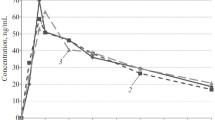Abstract
Blood pressure and heart rate responses to oral tyramine have been measured in healthy volunteers before and after administration of the selective monoamine oxidase B inhibitor selegiline at high dosage (30 mg/day). Treatment brought about a 2 to 4-fold increase in tyramine sensitivity and a concomitant small but significant reduction in plasma 4-hydroxy-3-methoxyphenylglycol concentration, pointing to the emergence of some degree of monoamine oxidase A inhibition. It is suggested that patients treated with selegiline 30 mg/day or more should be placed on a tyramine-free diet.
Similar content being viewed by others
References
Blackwell B, Mabbitt LA (1965) Tyramine in cheese related to hypertensive crises after monoamine-oxidase inhibition. Lancet I:938–940
Elsworth JD, Glover V, Reynolds GP, Sandler M, Lees AJ, Phuapradit P, Shaw KM, Stern GM, Kumar P (1978) Deprenyl administration in man: a selective monoamine oxidase B inhibitor without the “cheese effect”. Psychopharmacology 57:33–38
Glover V, Elsworth JD, Sandler M (1980) Dopamine oxidation and its inhibition by (-)-deprenyl in man. J Neural Transm [Suppl] 16:163–172
Glover V, Liebowitz J, Armando I, Sandler M (1982) β-Carbolines as selective monoamine oxidase inhibitors: in vivo implications. J Neural Transm 54:209–218
Goodwin BL, Sandler M (1987) Assay of plasma 4-hydroxy-3-methoxyphenylglycol (HMPG) by gas chromatography with electron capture detection (ECD). Abstr 6th Int Catecholamine Symp Jerusalem, p 121
Johnston JP (1968) Some observations upon a new inhibitor of monoamine oxidase in brain tissue. Biochem Pharmacol 17:1285–1297
Knoll J, Ecsery Z, Kelemen K, Nievel JG, Knoll B (1965) Phenylisopropylmethyl-propinylamine (E-250): a new spectrum psychic energizer. Arch Int Pharmacodyn 155:154–164
Lader MH, Sakalis G, Tansella M (1970) Interactions between sympathomimetic amines and a new monoamine oxidase inhibitor. Psychopharmacologia 18:118–123
Lipper S, Murphy DL, Slater S, Buchsbaum MS (1979) Comparative behavioural effects of clorgyline and pargyline in man: a preliminary evaluation. Psychopharmacology 52:123–127
Mann J, Gershon S (1980) l-Deprenyl, a selective monoamine oxidase type B inhibitor in endogenous depression. Life Sci 26:877–882
Mendis N, Pare CMB, Sandler M, Glover V, Stern GM (1981) Is the failure of (-)-deprenyl, a selective monoamine oxidase B inhibitor, to alleviate depression related to freedom from the cheese effect? Psychopharmacology 73:87–90
Pickar D, Cohen RM, Jimerson DC, Murphy DL (1981a) Tyramine infusions and selective monoamine oxidase inhibitor treatment. I. Changes in pressor sensitivity. Psychopharmacology 74:4–7
Pickar D, Cohen RM, Jimerson DC, Lake CR, Murphy DL (1981b) Tyramine infusion and selective monoamine oxidase inhibitor treatment. II. Interrelationships among pressor sensitivity changes, platelet MAO inhibition, and plasma MHPG reduction. Psychopharmacology 74:8–12
Quitkin FM, Liebowitz MR, Stewart JW, McGrath FJ, Harrison W, Ratkin JG, Markowitz K, Davies SO (1984) l-Deprenyl in atypical depressives. Arch Gen Psychiatry 41:777–781
Sandler M, Stern GM (1982) Deprenyl in Parkinson's disease. In: Marsden CD, Fahn S (eds) Neurology 2, movement disorders. Butterworth, London, pp 166–173
Simpson G, White K, Pi E, Razani J, Sloane RB (1983) Monoamine oxidase inhibition and tyramine sensitivity in l-deprenyl-treated subjects. Psychopharmacol Bull 19:340–342
Squires RF (1972) Multiple forms of monoamine oxidase in intact mitochondria as characterized by selective inhibitors and thermal stability: a comparison of eight mammalian species. In: Costa E, Sandler M (eds) Monoamine oxidases — new vistas. Raven Press, New York pp 355–377
Sunderland T, Mueller EA, Cohen RM, Jimerson DC, Pickar D, Murphy DL (1985) Tyramine pressor sensitivity changes during deprenyl treatment. Psychopharmacology 86:432–437
Tringer L, Haits G, Varga E (1971) The effect of (-)-phenylisopropylmethyl-propinylamine HCl in depression. Soc Pharmacol Hung Fifth Conference on Hungarian Therapeutics, pp 111–114
Varga E, Tringer L (1967) Clinical trial of a new type of promptly acting psycho-energetic agent (phenyl-isopropylmethyl-propinylamine-HCl, E-250). Acta Med Acad Sci Hung 23:289–295
Author information
Authors and Affiliations
Rights and permissions
About this article
Cite this article
Prasad, A., Glover, V., Goodwin, B.L. et al. Enhanced pressor sensitivity to oral tyramine challenge following high dose selegiline treatment. Psychopharmacology 95, 540–543 (1988). https://doi.org/10.1007/BF00172970
Received:
Revised:
Issue Date:
DOI: https://doi.org/10.1007/BF00172970



